Plextor recently announced the PX-M2P SSD, their third generation SSD. Plextor has steadily been developing their SSD chops since they began working in the space just 18 months ago and it shows with the PX-M2P. Plextor is using the Marvell 9174 processor, Toshiba 32nm Toggle NAND and a SATA 6Gb/s interface to deliver read speeds of 500 MB/s, writes of 440 MB/s and sequential 4K IOPS of 70,000. But it’s Plextor’s “True Speed” technology that might be the most interesting feature, a home-grown software that delivers consistent performance even after the drive has been written to extensively. Plextor is also pitching excellent steady state performance, something not generally promoted for client SSDs, as they usually crumble when placed under that level of stress.
But Plextor isn’t really pitching this as a client SSD; in fact they’d prefer we look at this like an enterprise drive. The truth is, the Marvell 9174 processor has been used in both client and enterprise SSDs. Crucial for instance uses the same processor in their client C300 SSD and enterprise Micron P300. The big difference between those and what Plextor is doing, is both in the NAND and software. Plextor is the first to use Toshiba’s Toggle MLC NAND (the P300 uses SLC NAND) with the Marvell 9174 to deliver an enterprise-ready solution.
Beyond True Speed, Plextor is excited about their custom firmware for the SSD, something not always seen these days. Plextor is also trying to show they mean business in the SSD quality department. Before an M2P SSD leaves the factory, each drive goes through a thorough testing process, including a 20-hour high temperature burn-in test and simulations of real-world working environments. This nets what Plextor calls one of the lowest average annual failure rates of .5%.
Plextor M2P SSDs are available in a streamlined offering of 128GB (PX-128M2P) and 256GB (PX-256M2P) capacities. The drives are shipping now with a suggested retail of $240 and $450 respectively.
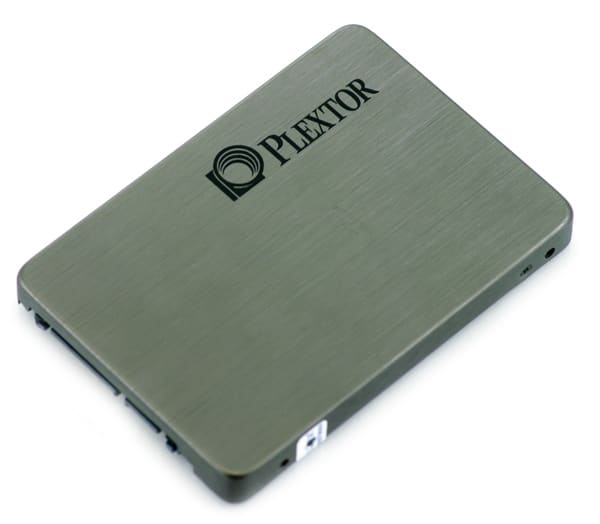
Plextor PX-M2P Specs
- Formatted Capacity – 238.47GB
- Marvell 9174 processor
- SATA 6 Gb/s interface
- Toshiba Toggle MLC NAND
- 500 MB/s read, 440 MB/s write, 70,000 4K IOPS
- 256MB Buffer (128GB), 512MB Buffer (256GB)
- Power consumption – 5W active, .1W idle
- 3 year warranty
- MTBF – 1.5 Million Hours
- Mounting bracket and cloning software included
Design and Build
Plextor uses an all-metal body with the PX-M2P, giving it a durable feel and a stylized look. The metal alloy used is presented with a brushed metal finish, adding a bit of texture and a very solid feel with the drive in your hand. Both top and bottom match in color and finish, which adds to the appearance and really rounds off this SSD.
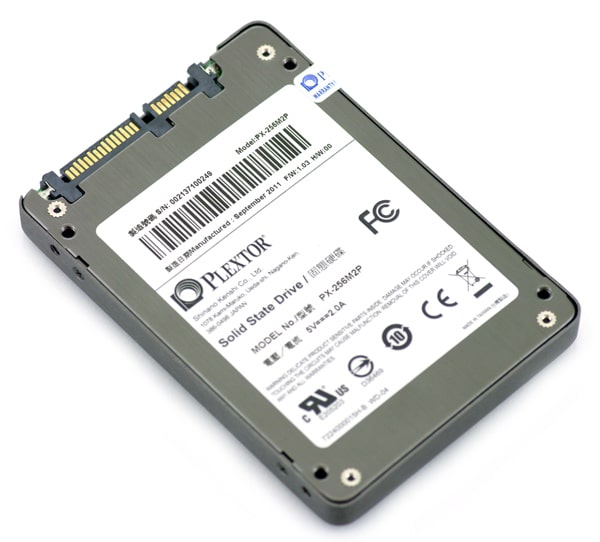
The side of the drive shows off the screws that hold the two case halves together, as well as standard horizontal mounting points. The bottom also includes mounting points as well for attaching this drive to sleds and hot-swap bays.

The front of the drive includes the standard SATA power and data interface, with no service pins visible or other attributes.
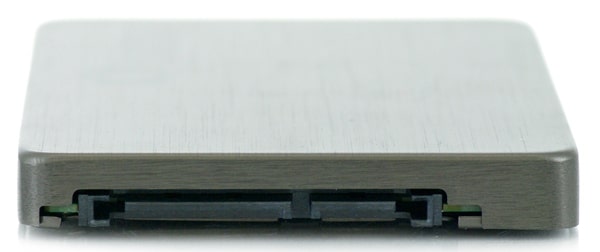
Disassembly
Taking the Plextor PX-M2P apart is very simple, but voids your warranty in the process. To split the SSD apart, you simply remove the four Phillips head screws from the perimeter of the drive (one breaking the warranty voiding sticker) and then use a fingernail to split the case open.
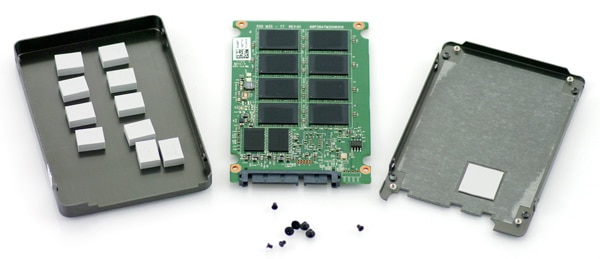
With the drive apart, you can see the top side of the circuit board, held in with four additional screws. Another cool feature is the use of thermal pads inside the case, used to disperse heat away from components. One is included for each major component, including the RAM, NAND, and controller.
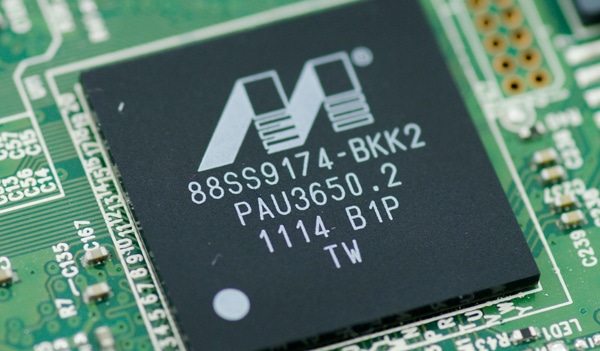
Plextor uses a SATA 6.0Gb/s Marvell 88SS9174-BKK2 controller, which is also found inside the Micron P300 and Crucial C300. This versatile controller is seen in both consumer and enterprise drives and has proven itself to be very reliable.
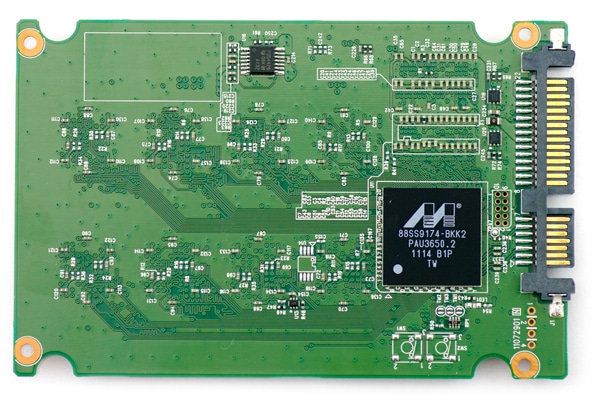
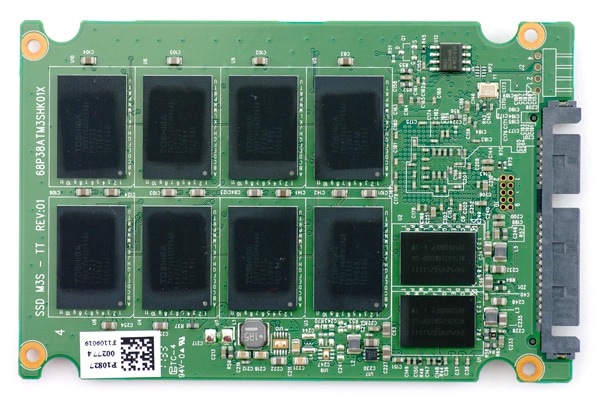
Routed through the Marvell controller are two 256MB Nanya RAM chips and eight 32GB Toshiba 34nm toggle NAND pieces. This is a rather unique combination since up until now we have only seen toggle NAND present inside SandForce-powered SSDs, not to mention quadruple the RAM of most 256GB SSDs.
Synthetic Benchmarks
When it comes to synthetic benchmarks, one good starting point to see where a drive might stand initially is the manufacturer quoted read and write speed. While not the best indicator of real-world performance, it does how fast the drive is when moving large files on and off the flash. In this case Plextor quotes 500MB/s read and 440MB/s write with sequential file transfers. Our first IOMeter test checks how well these values hold up.
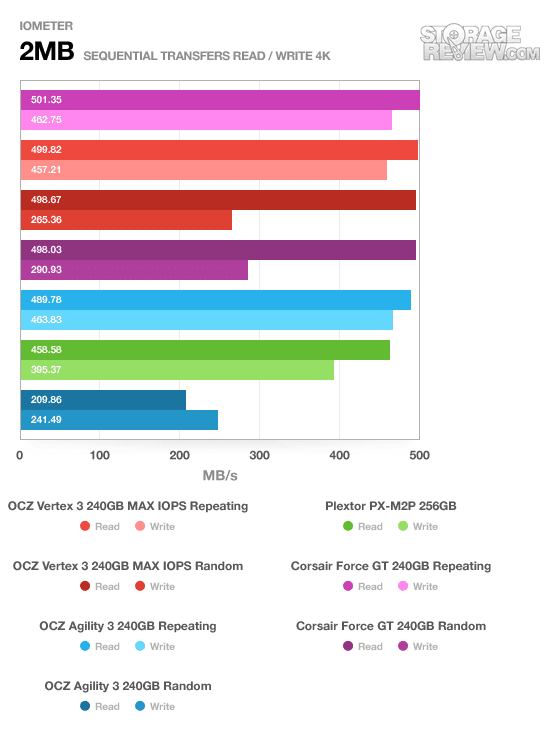
We measured 458MB/s read and 395MB/s write on the PX-M2P in our first sequential transfer test. These numbers are about 50MB/s slower on each side compared to the spec sheet.
Our next test keeps the same 2MB transfer size, but changes from sequential to a random transfer.
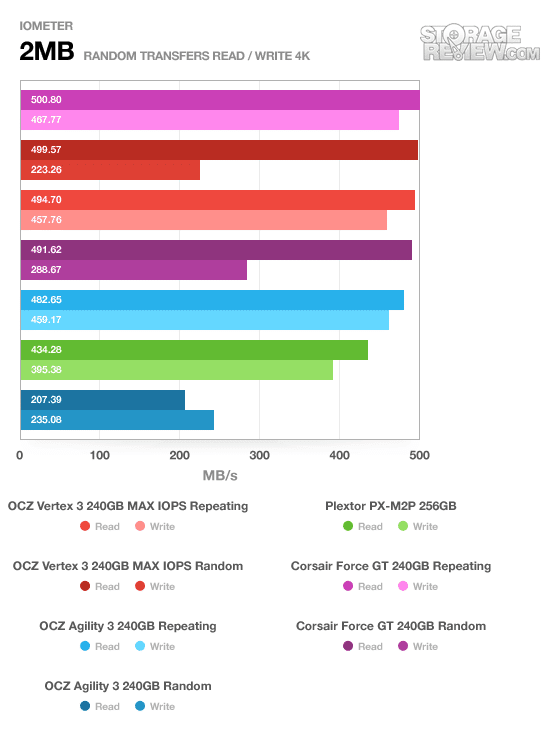
In this test the 256GB Plextor PX-M2P stayed roughly in line with the sequential transfer test, but dropped slightly in read speeds down to 434MB/s read and 395MB/s write.
Our next test looks at random 4K read and write performance, which is the bread and butter of every SSD. This first segment looks at drive with a queue depth of one.
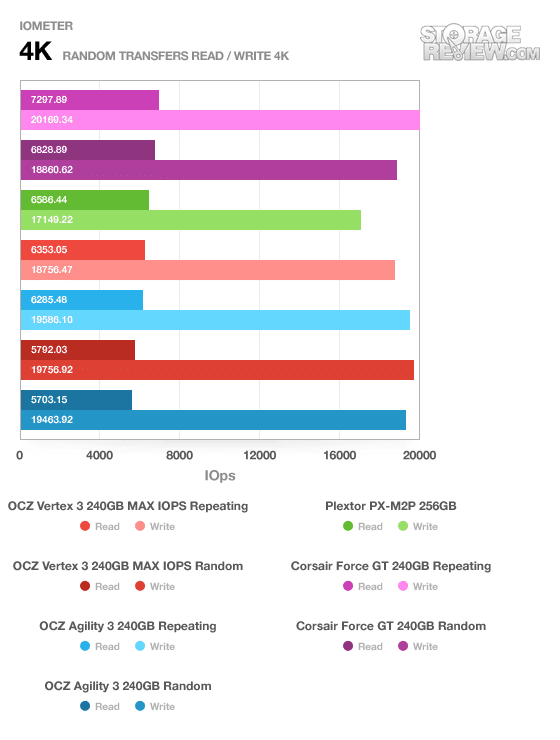
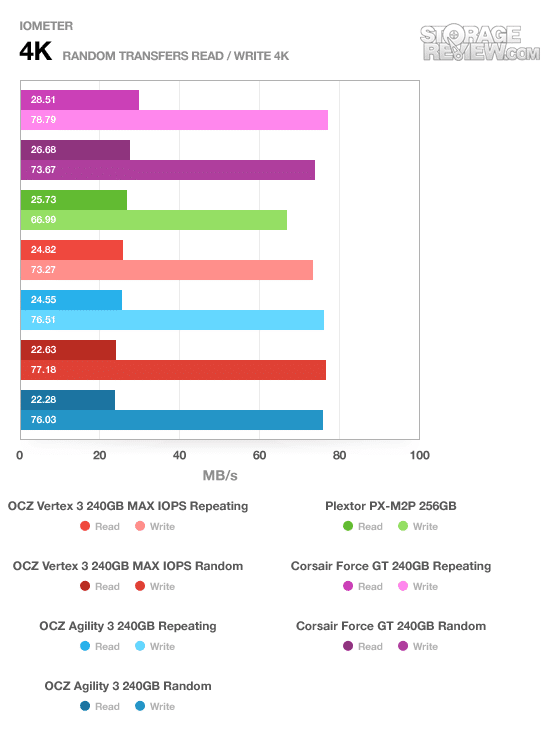
The Plextor PC-M2P fared well in this test with read speeds near the top of the pack, just below the Corsair Force GT. Write speeds were slightly less than the SF-2200 powered SSDs, measuring 67MB/s or 17k IOPS versus 76MB/s or 19k IOPS or greater of the other SSDs.
When it came to higher queue depth 4K read and write tests, the Plextor PX-M2P lived up to its claim of 70k IOPS, putting itself right at the top of our charts.
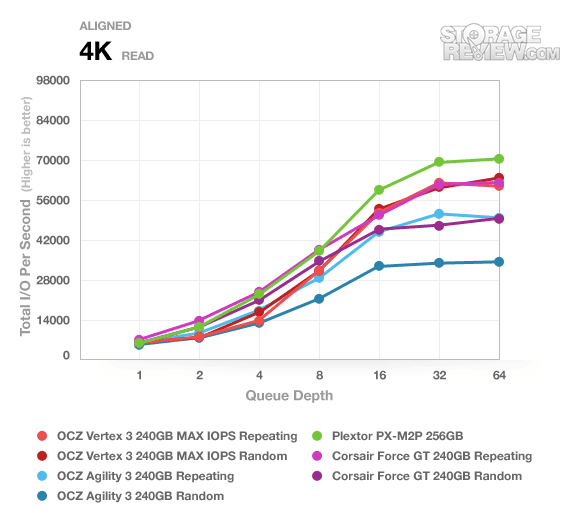
The 256GB Plextor PX-M2P topped out at 70K IOPS, well above the other SandForce-powered SSDs. The lead increases when you compare it to the SandForce models working with incompressible data as well.
Write speeds fell in between the SF-2200-powered compressible and incompressible drive speeds.
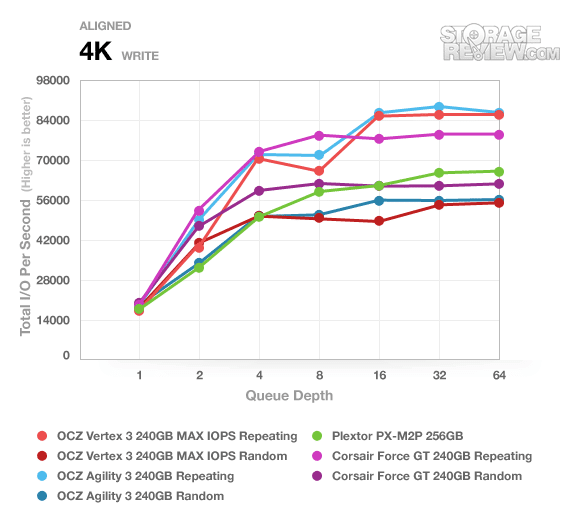
With its slower queue depth=1 random 4K write speeds, the Plextor PX-M2P came in towards the bottom in our average write latency test. With its slower average speeds though, it still walked away with the lowest peak latency of 6.77ms.
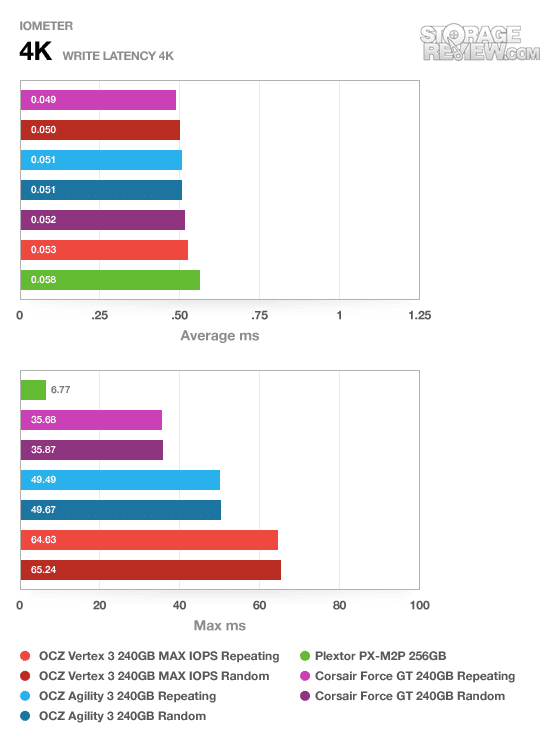
Given the Marvell controller which doesn’t compress data on the fly as it is written to the SSD, the Plextor PX-M2P saw no performance degradation when switching to fully randomized data in our CrystalDiskMark test.
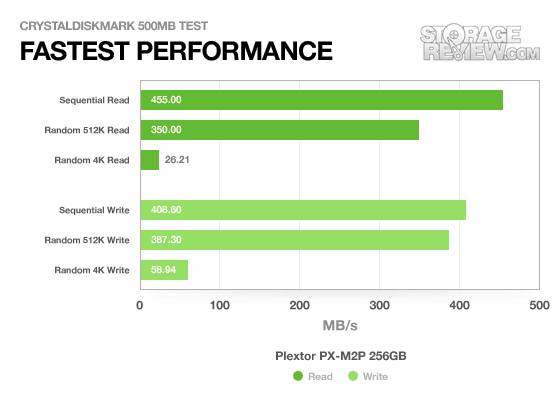
The last section of our synthetic benchmark group uses IOMeter with standard server profile tests. In this area the Plextor PX-M2P performed very well, staying middle of the pack; above the SandForce models working with incompressible data, but lower than those models with fully repeating data. In a real-world setting the SandForce-powered models would probably sit somewhere in the middle, near where the Plextor SSD scored.
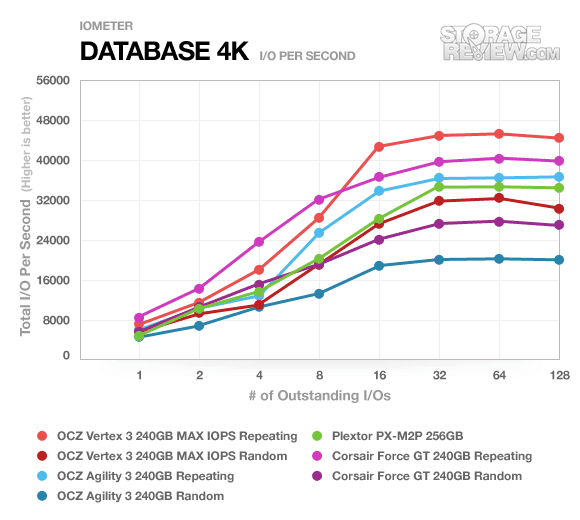
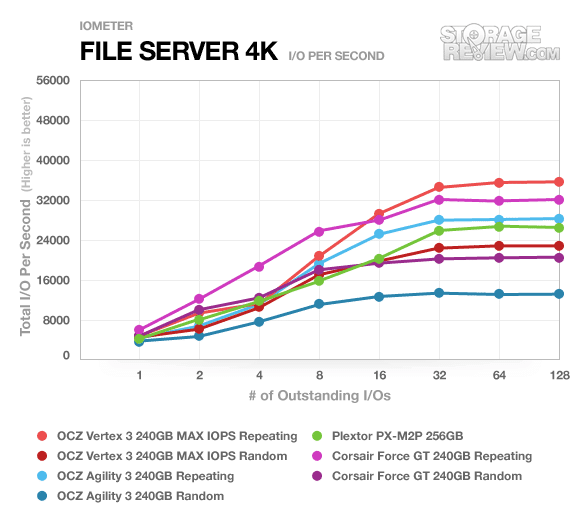
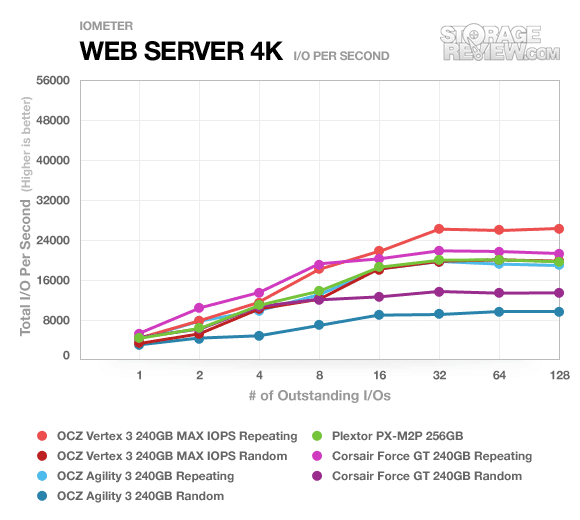
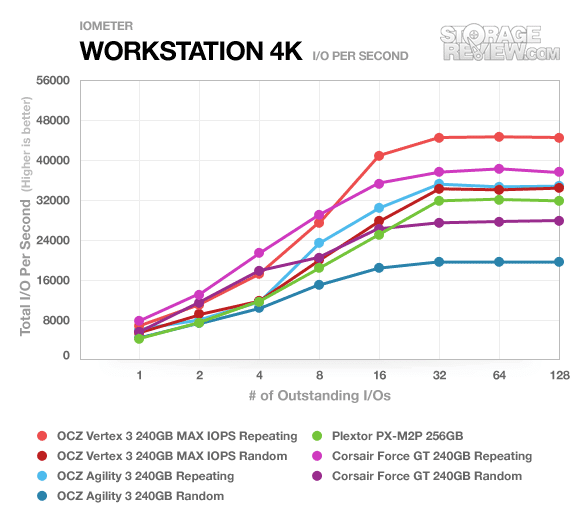
Enterprise Benchmarks
Given the enterprise market Plextor plans to enter with this drive, we saw it very fitting to put this drive through our intensely stressful 4K random write steady-state benchmark. The last drive that was put through this same test was the SLC-equipped Micron P300, which is easily classified as pure enterprise. Given the unique NAND configuration, high RAM amount, and tweaked firmware we were very curious how the PX-M2P would perform.
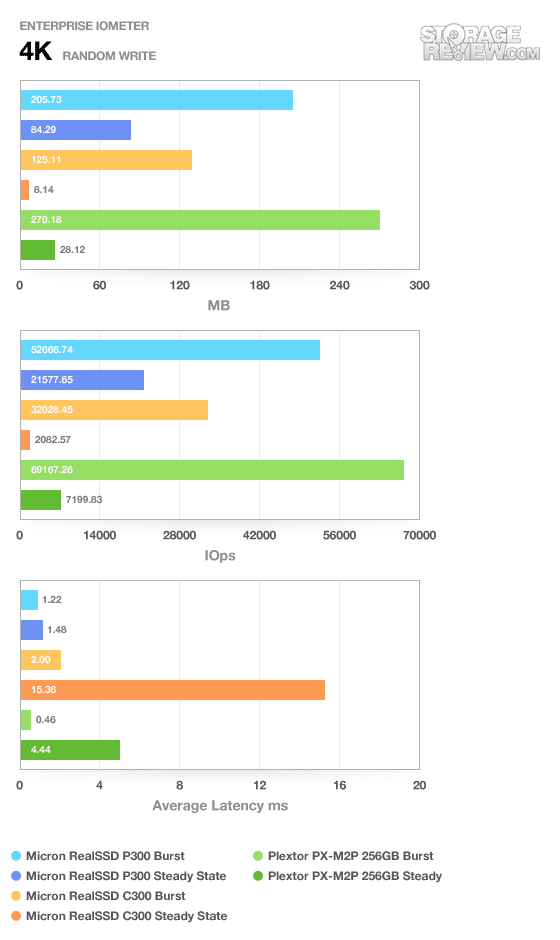
Its a given that any drive put through the steady-state benchmark will have a significant performance drop between before and after. Comparing the consumer-targeted C300 to the enterprise-targeted P300, we notice a 60% drop on the P300 and 94.5% drop on the C300. Clearly the P300 held up better in a 24/7 write environment. The Plextor PX-M2P saw a performance drop of 89.6%, which fared better than the C300… not to mention had a faster peak speed to drop from. It also walked away with a steady-state random 4K write speed of 28.12 MB/s or 7.2K IOPS, which is not bad considering the price difference between it and the SLC-based P300.
Real-World Benchmarks
If you are new to StorageReview, one thing we try to focus on is how any given drive might perform under real-world conditions. For the average user, trying to translate random 4K write speeds into an everyday situation is pretty difficult. It helps when comparing drives in every setting possible, but it doesn’t exactly work out into faster everyday usage or better game loading times. For this reason we turned to our StorageMark 2010 traces, which include HTPC, Productivity, and Gaming traces to help readers find out how a drive might rank under their conditions.
The first real-life test is our HTPC scenario. In this test we include: playing one 720P HD movie in Media Player Classic, one 480P SD movie playing in VLC, three movies downloading simultaneously through iTunes, and one 1080i HDTV stream being recorded through Windows Media Center over a 15 minute period. Higher IOps and MB/s rates with lower latency times are preferred. In this trace we recorded 2,986MB being written to the drive and 1,924MB being read.
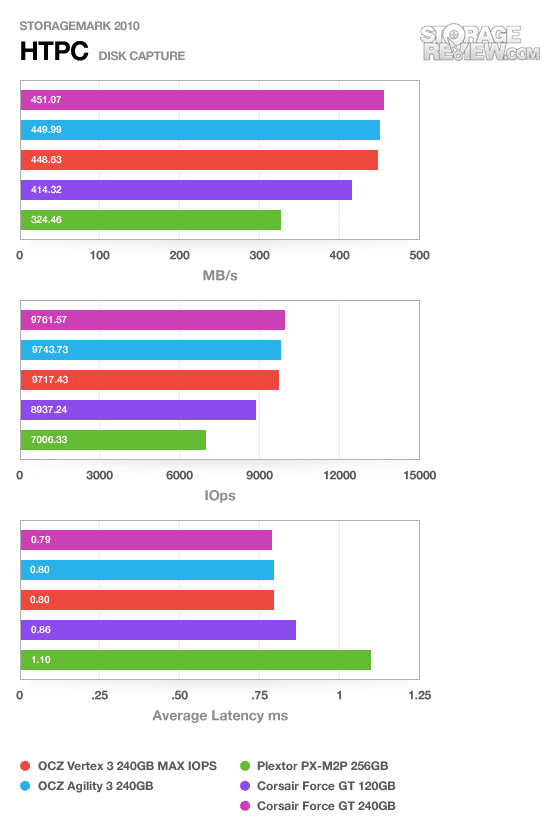
Compared to the SandForce SSDs the Plextor PX-M2P didn’t really hold up as well in our HTPC trace. It fell behind the group, but still averaged a very respectable 324MB/s average speed.
Our second real-life test covers disk activity in a productivity scenario. For all intents and purposes this test shows drive performance under normal daily activity for most users. This test includes: a three hour period operating in an office productivity environment with 32-bit Vista running Outlook 2007 connected to an Exchange server, web browsing using Chrome and IE8, editing files within Office 2007, viewing PDFs in Adobe Reader, and an hour of local music playback with two hours of additional online music via Pandora. In this trace we recorded 4,830MB being written to the drive and 2,758MB being read.
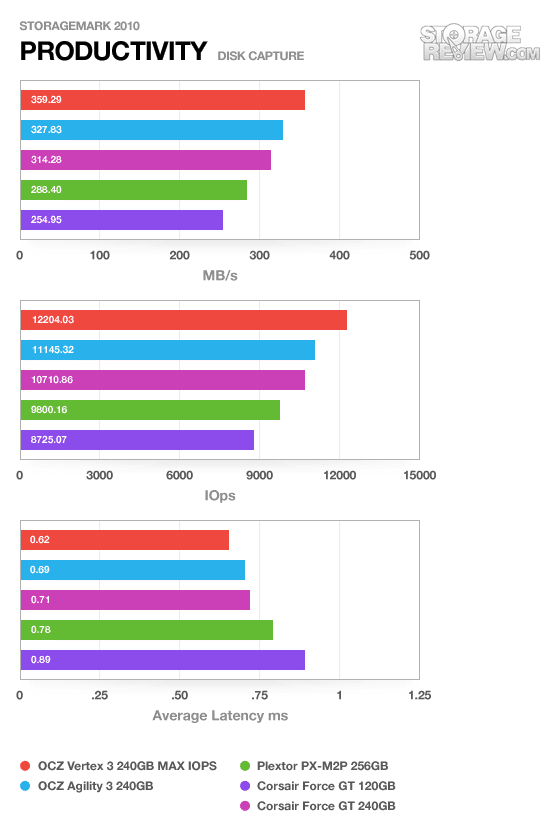
The Plextor SSD moved up the group in our Productivity trace, with an average speed of 288MB/s. It still couldn’t keep up with the Vertex 3 MAX IOPS though, which lead the way with a 359MB/s average.
Our third real-life test covers disk activity in a gaming environment. Unlike the HTPC or Productivity trace, this one relies heavily on the read performance of a drive. To give a simple breakdown of read/write percentages, the HTPC test is 64% write, 36% read, the Productivity test is 59% write and 41% read, while the gaming trace is 6% write and 94% read. The test consists of a Windows 7 Ultimate 64-bit system pre-configured with Steam, with Grand Theft Auto 4, Left 4 Dead 2, and Mass Effect 2 already downloaded and installed. The trace captures the heavy read activity of each game loading from the start, as well as textures as the game progresses. In this trace we recorded 426MB being written to the drive and 7,235MB being read.
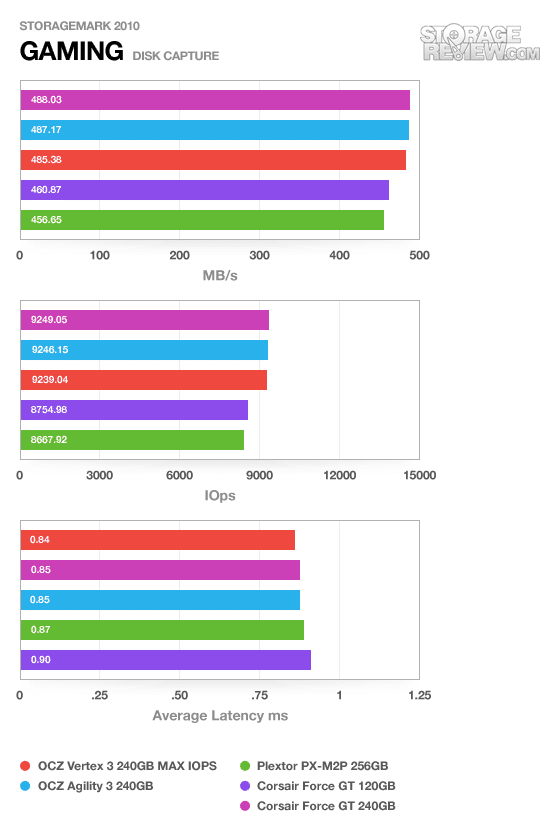
In the third and final consumer trace the Plextor lagged behind the group in gaming performance, although only just. It scored 456MB/s average, compared to 488MB/s at the top of the chart from the Corsair Force GT 240GB. Overall pretty impressive results against the fastest drives on the market.
Power Consumption
Going from the spec sheet, Plextor lists an average active power rating of 5 watts and an idle rate of 0.1 watt. Compared to other drives in this class, those values do run a bit high, although sometimes manufacturer claims can be higher than what we find in our lab.
As it turned out in the case of power consumption while writing data to the drive, the PX-M2P measured 5.85 watts during our sequential 2MB write test. The only higher power measurement was the startup value, measuring 6.06 watts. Sequential read and random read fared better, measuring 3.16 watts and 0.78 watts respectively. Idle was 0.33 watts, which ranked towards the average we find on most SSDs these days.
Warranty
The Plextor PX-M2P SSD offers a three year warranty, which is normal in the SSD space, however shorter than the five year warranty offered by some drives.
Conclusion
Plextor boldly touted enterprise-grade materials and specs in their PX-M2P SSD. Since they asked for it, we put it through our rigorous steady state test, where it actually held up pretty well – not all SSDs can handle that level of pounding. The M2P fell in between the client C300 and enterprise P300, which use the same processor but different NAND configurations. The Plextor was able to start off at a speed far surpassing either model thanks to the Toshiba toggle NAND and extra cache and finished at roughly a third of the speed of the SLC-based P300, which costs almost triple the price for almost a third of the Plextor’s 256GB capacity.
While we put significant emphasis on steady state performance, the M2P held up generally well throughout our benchmarking, even topping the charts in the 4K aligned read test. It rarely looked bad anywhere, largely keeping pace with the fastest SSDs available. For most synthetic benchmarks the Plextor PX-M2P fell smack dab in between the SandForce compressible and incompressible tests. In a worst case environment, with completely randomized data, it scored above the SF-2200 group.
Overall the Plextor PX-M2P brings a lot to the table highlighted by Toshiba Toggle NAND, this first time we’ve seen it used in an SSD powered by a Marvell processor. Plextor also offers custom firmware and True Speed software to improve steady-state performance, and delivers reliability testing generally not found in consumer SSDs.
Pros
- Held up well in a steady-state write environment
- Unique NAND configuration for a Marvell-powered SSD
- Each drive includes burn-in testing before leaving the factory
Cons
- Couldn’t beat SandForce-powered models in real-world tests
Bottom Line
The Plextor PX-M2P SSD isn’t flashy, but offers very good performance and hangs well with the highest performing SSDs we’ve tested to date. It’s a welcome alternative in the enthusiast grade SSD class and is one of the best implementations of the Marvell processor we’ve seen to date.


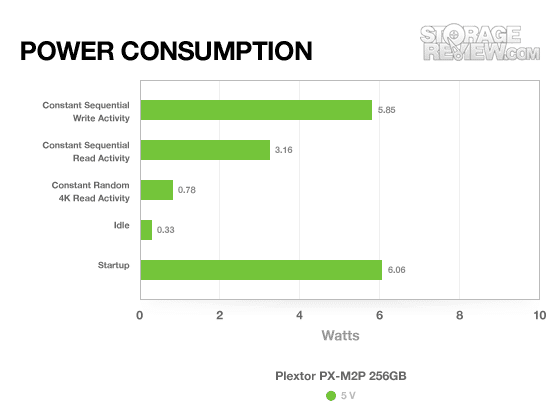


 Amazon
Amazon